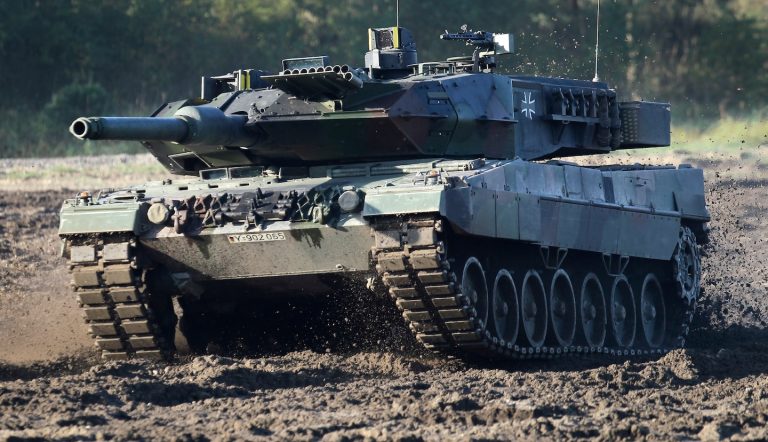Speaking to reporters in London, Bastian Giegrich, director general of the International Institute for Strategic Studies, said the multiple factors present “a picture of strategic instability and a new era of contested powers.” He pointed to Russia's ongoing invasion of Ukraine, China's military modernization, conflicts in the Middle East, and military coups in Africa.
The IISS report also highlighted the extreme destruction caused by war. In Ukraine, the International Institute for Strategic Studies estimated that Russia had lost nearly 3,000 main battle tanks since its invasion in February 2022. These losses exceeded the total tanks in Russia's pre-war active inventory, forcing it to pull older vehicles from storage.
Meanwhile, NATO member states' defense spending has risen to about 50 percent of the global total, the International Institute for Strategic Studies report said, a staggering percentage for a military alliance whose member states represent less than one-eighth of the world's population.
The new estimates of increasing global military budgets coincide with repeated statements by former President Donald Trump about the levels of defense spending by US allies. He said at a campaign rally over the weekend that he would encourage Russia to do “whatever it wants” with NATO members who have not spent the alliance's target of 2 percent of gross domestic product on defence.
“You didn't pay. 'You're a delinquent,'” Trump allegedly told a foreign leader while he was president.
Ukraine war pushes Europe
While the United States still accounts for the bulk of NATO's defense spending, the London-based International Institute for Strategic Studies found that non-US members collectively increased their military spending by 32% in the decade after Russia illegally annexed Crimea in 2014, with the most growth. Which occurred in the last two years.
Last year, ten EU member states achieved the stated target of spending 2% of their gross domestic product on defence, up from eight the previous year. The International Institute for Strategic Studies found that all European NATO members met the benchmark of allocating 20% of their spending to equipment.
The alliance has also been strengthened by Finland, a new member as of last year with a large standing army, and by the potential accession of Sweden. Several major countries, including France and Germany, have announced long-term plans to boost spending.
However, the International Institute for Strategic Studies also noted that some of these countries, especially Germany, remain well below the 2% GDP target. Just last year, NATO members rejected a pledge to ensure their defense budgets exceed 2%.
The International Institute for Strategic Studies also warned that inflation and economic turmoil had dulled the impact of some increases in defense spending, while rising demand had led to the fact that “European arms production was not geared for wartime.”
Russia and China continue to strengthen budgets
While the West is spending more on military budgets, Russia and China are doing the same. With lower costs and greater government involvement in the defense industry, they often seem to get more for their money.
The International Institute for Strategic Studies reported that Russia's total military spending rose by about 30% last year as the war in Ukraine continued, and it is estimated that the Kremlin now spends approximately 7.5% of its gross domestic product on the military. The country has significantly reformed its defense industry since it became clear that it was not prepared for war in Ukraine.
Russia's total military spending is estimated at $108 billion in 2023, more than three times that of Ukraine ($31 billion). However, unlike Russia, Ukraine has often been able to replace lost equipment with better Western-supplied counterparts, the International Institute for Strategic Studies noted.
Military aid to Ukraine has become hostage to the bitter political division in the United States. The Senate provided $60 billion in aid to Ukraine this week, but hard-right lawmakers in the House of Representatives are expected to try to block that.
Last year, China increased its defense spending for the 29th consecutive year, the International Institute for Strategic Studies reported, although lower-than-expected economic growth helped ensure its share of gross domestic product remained below 2%. The International Institute for Strategic Studies noted that Beijing is in the midst of a military modernization program aimed at creating a “world-class” military that relies less on foreign technology by mid-century.
China's ambitions have helped spur military spending among its neighbours, with Taiwan announcing its largest military budget at $19 billion – or about 2.6% of GDP. Japan and South Korea have also boosted their military spending, partly due to threats from North Korea, the International Institute for Strategic Studies said.
The United States remains the country with the largest military spending in the world. Its budget of $900 billion in 2023 was larger than the budgets of the top fifteen countries combined. But while the war in Ukraine strained the US defense industry, the International Institute for Strategic Studies found that spending as a share of GDP – 3.36% in the US – was lower than in previous eras.
“This compares to Cold War defense spending of 8% on a much lower GDP,” Dana Allen, a fellow at the International Institute for Strategic Studies, told reporters in London. “So clearly this does not put a lot of pressure on the United States.”

